SOUTH DAKOTA SOYBE A N LEADER
2023 Spring Check-In
Soy Industry News

5 Ways to Protect Your Soybean Crop from Drought

Understanding Carbon Credit Programs for Soybean Producers

Soil Health
Soy-Based Fuel Have a Positive Economic Impact
A publication of the South Dakota
Association Spring Issue 2023
Soybean
REMEMBER, HE CREATED YOU FOR THIS.
Don’t be afraid. Just believe. Mark 5:36

President
Kevin Deinert, Mount Vernon
First Vice President
Chad Schooley, Castlewood
Second Vice President
Jeff Thompson, Colton
Secretary
Drew Peterson, Salem
Treasurer
Brent Greenway, Mitchell
Directors
Chad Nelsen, Viborg
Chad Schooley, Castlewood
Derrick Scott, Geddes
John Horter, Andover
Jamie Johnson, Frankfort Jesse King, Toronto
ASA Corteva Young Leaders
21-22 Tanner Hento, Avon
22-23 Jeff Kloucek, Tabor
Industry Representatives
Kari Vander Wal, South Dakota Soybean Processors

Joe Schefers, Bayer Crop Science
Terry Schultz, Mustang Seeds
Travis Bunde, Raven Industries
Jeff Behrens, Pioneer
American Soybean Association
Brandon Wipf, Huron
Jordan Scott, Valley Springs
Editor/Design Director
Mariah Kessler, SD Soybean Communications Director
South Dakota Soybean Leader is published four times a year by the South Dakota Soybean Association, 5000 S. Broadband Lane, Suite 100, Sioux Falls, SD 57108 Phone: 605-330-9942. For address corrections contact South Dakota Soybean Leader at 5000 S. Broadband Lane, Suite 100, Sioux Falls, SD 57108. www.sdsoybean.org | sdsa@sdsoybean.org
Comments and statewide news articles should be sent to the above address. Advertising space reservations must be made by the first of the month preceding publication. In consideration of the acceptance of advertisement, the agency and the advertiser must, in respect of the contents of the advertisement, indemnify and save the publisher harmless against any expense arising from claims or actions against the publisher because of the publication of the content of the advertisement.
Advertising Inquiries
Garrett Gross, AGE Media
(605) 251-6370 | garrett@agemedia.pub www.agemedia.pub
FARMERS ADAPT AND DIG IN DURING TOUGH TIMES
Hello, my name is Kevin Deinert, your new President of the SDSA.
First off, I would like to thank our past president Jordan Scott for all his dedication, leadership, and hard work. He continues to be an integral part of our association and helps me any way he can. Thank you, Jordan!
For the past six years, I have served as a director on the SDSA board. In 2016, I was selected as a representative for South Dakota to the ASA/DuPont Young Leader program and awarded a seat on the board. A year later, I was elected to serve a three-year term on the board and have continued to serve in various capacities. The camaraderie and respect each board member has for another has helped me continue to develop into a leader chairing committees or officer positions. I am thankful for the leadership training I have received along the way and hope to continue to uphold the standard of being the president for SDSA.
No doubt being president holds its challenges and responsibilities, but I’m excited to see how we can work together to showcase how great the South Dakota farmer is. My passion for farm advocacy has grown through my time here with SDSA. Seeing the various issues that have arisen in the political landscape, I see now that our voices as farmers need to be heard. With my board of directors, I am confident that we will be able to help shape the farming community in South Dakota for the better and look forward to advocating wherever challenges may arise.
Anyone else tired of snow? Just when we think we have gotten through the years of a global pandemic and continuing struggle with supply chain issues and inflation, Mother Nature decides it is her turn to challenge us again this winter. We thought that dry winters were our new normal, but Mother Nature reminded us that it does still snow up here in South Dakota. Let’s just be thankful that unlike the days of old, we now have heated cabs and 4WD.
And just when we think we have mitigated the burdens of winter, the financial side of farming rears its ugly head too. Now I know some of the old timers would tell me “kid, you didn’t live through the eighties.” And they are right, and I’m glad I was just born in them, but we find ourselves looking back at history to see how we can manage the future. Interest rates on the rise, increased fixed costs, and solving the elusive “is that part available and when will it get here?” questions have been at the forefront of farmers everywhere this year. But again, I am amazed at how we, as farmers, continue to adapt and dig in when things get tough. I still see the excitement in everyone’s eyes as we look forward to another year in the fields and hopefully, we will continue to receive great prices for our crops, have timely/adequate rains, and safety as we go into crop year 2023.
I would be remiss if I didn’t introduce myself a little more. Again, my name is Kevin Deinert, and I farm near the small town of Mount Vernon, S.D. There with my brother and father, we primarily grow corn and soybeans with various small grains and alfalfa for feed. When not tending to our crops, our family operates a cow/calf herd and beef feedlot. I also spend my time as a crop insurance agent and sports official. I am a graduate of South Dakota State University with degrees in Animal Science and Chemistry. Married to my lovely wife Brianna for almost 6 years, we have two children, Luke (2) and Wyatt (newborn). My family, no doubt, has made me the man I am today. Their continued support and love have helped me to become a better friend, father, and husband. I cannot thank them enough for allowing me to give my time to SDSA so that I may help and advocate for others.
Family has been and continues to be the backbone of our industry. Almost every farmer I have talked to always mentions their family farm’s heritage and how it has shaped their future. Whether it be the family in our homes or the neighbors down the road, we continue to lean on each other through the good and bad. I know our board and staff consider ourselves part of the soybean family. And just like any family, we continue to uplift and support each other to achieve the greater good.
While COVID may have distanced us, I challenge everyone to reconnect with loved ones and neighbors. You never know what your words and time may mean to another. Let us go into 2023 with the excitement that only farming can bring and the hope of a great year.
Spring Issue 2023 SDSL 3
PRESIDENT’S OUTLOOK
Kevin Deinert, President of SDSA, and family
Paying checkoff does not automatically make you a member of SDSA. SDSA has membership dues.

Spring Issue 2023 SDSL Spring Issue 2023 | Volume 12 Number 1 A public a tion of t he S ou t h Dakota S oybean As so ci at io n SO U T H D A K OT A S OY B E A N L E A D E R SDSL 3 President’s Outlook 5 Letter From the Chairman 6 Soy Industry News 9 Letter from the Executive Director 10 5 Ways to Protect Your Soybean Crop from Drought 12 Soybean Legislative Report 14 Understanding Carbon Credit Programs for Soybean Producers 15 Checkoff Supported Export Promotion Pays Off 16 U.S. Farmers Delivering Sustainably Grown Grains 18 Soil Health: The Michalski Family, Boost Farm Succession Through Soil Health Practices 21 Farmer-led Groups Work for Healthier Soils 22 Sioux Falls Chamber of Commerce Honors Soybean Farmer/Leader 23 River Level has Impact on Shipping Capacity 24 Sioux Falls’ Elaina Lanson Sees What Farming as a Family Truly Means 26 Hungry for Truth: Recipe 27 Soy-Based Fuels have a Positive Economic Impact 30 SD Soybean Morocco Trade Mission Builds Trust Between Farmers and Buyers 32 Quality Counts. South Dakota Farmer is Excited for the Future Following SE Asia Tour 34 Soybean Growers Ready for Population-Growth Challenge 35 The Food System is Doing Just Fine
A publication of the South Dakota Soybean Assoc at on Winter Issue 2020
SOUTH DAKOTA SOYBE A N LEADER
LETTER FROM THE CHAIRMAN
By Jason Frerichs, Chairman of the South Dakota Soybean Research and Promotion Council

Greetings!
This winter has proven to test our patience, but we are focused on the spring work ahead to plant our crops and the renewed hope of a good year ahead of us. Thank you to the fellow soybean producers who have hosted and attended Shop Talks where our partners with SD Soybean share the latest updates. The collaboration at these Shop Talks includes: farm and ranch management bookkeeping, USDA, transition planning, congressional updates, and farmer leaders who serve on our soybean boards.
We should all be proud of the impact our soybean checkoff can make in expanding world markets. The area of strong importance right now is the Southeast Asia area. Our partners, United States Soybean Export Council (USSEC) and Northern Soy Marketing (NSM), have recently hosted trade missions connecting in-country livestock producers with our soybean farmers.
I commend our partners for working hard to open new markets and forge strong relationships with our friends in trade. If you are curious about some of these SE Asia countries, here is a snapshot: Indonesia is the largest country in SE Asia, with a middle class hungry for soy along with fish and poultry. The Philippines are proud to prefer U.S. Soy, and we continue to welcome the growth and friendship of U.S. Soy in Thailand and Vietnam. We will continue to work hard to find opportunities to
export soybean meal from the United States with the expected increase in more soybean crush facilities coming online soon.
Our soybean checkoff is strategically aligned with goals to enhance trade, increase domestic uses of soybeans and soy products, consumer education, and communicate our message. All of us involved directly in production agriculture have the unique perspective to tell our story. When you get a chance to talk about your operation, please seize the opportunity.
I am proud to be the fourth generation to farm here in the Whetstone Valley of Northeast South Dakota. Our family farm operation raises soybeans, corn, wheat, alfalfa, and a beef cattle cow/calf enterprise. My fellow family members on our farm each have unique roles along with our employees, but in the end, we all have the same goal: to make a living on the land.
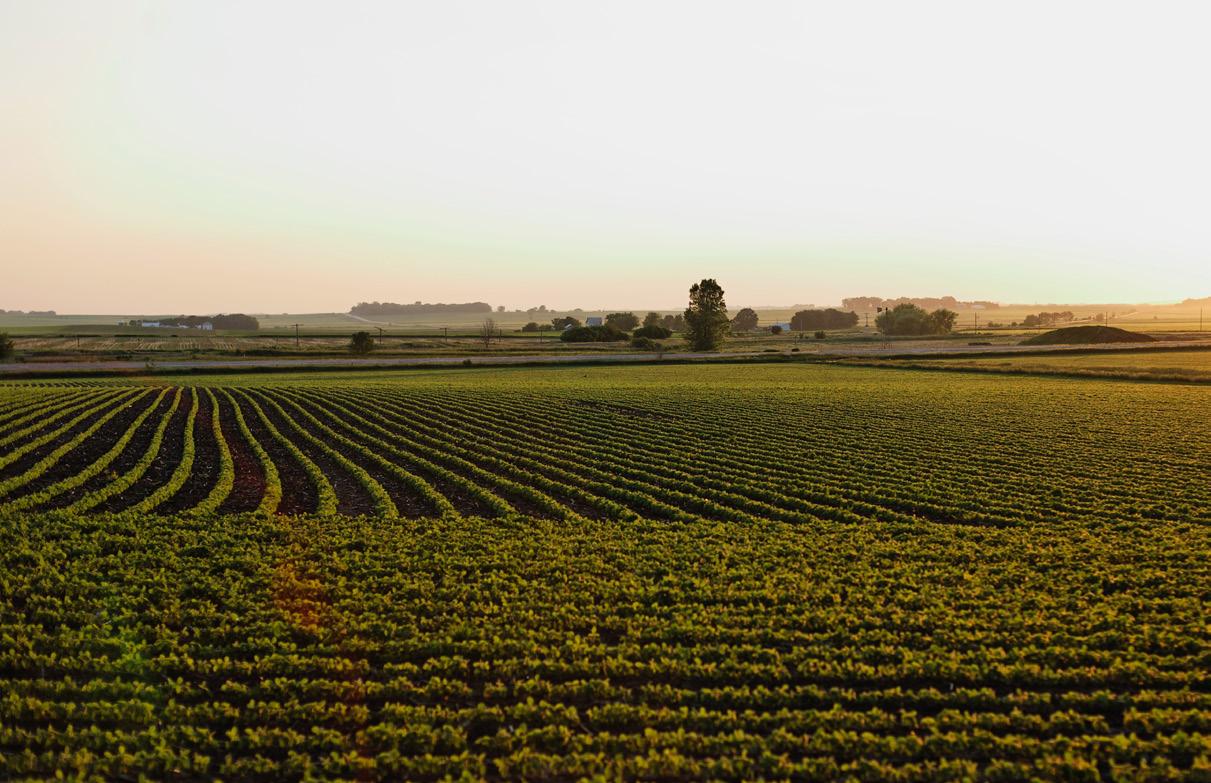
Spring Issue 2023 SDSL 5
JASON FRERICHS SDSRPC Chairman
INVESTING CHECKOFF DOLLARS
Soy Industry NEWS
SDSA visited Capitol Hill
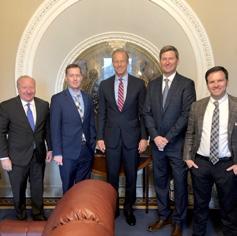
Ag Fest
SDSA served shrimp and cheesecake at Ag Fest on January 9 in Pierre after a board meeting. The event was well attended and hosted great conversations about the legislative session and policy.
Finding Common Ground
SDSRPC Director
Dawn Scheier and SD Soybean staff

Mariah Kessler attended the Common Ground conference to build connections and learn about how to better reach consumers.
Common Ground works through over 200 volunteers nationwide to connect with consumers through individual outreach and advocacy as well as events and promotion organized by state chapters. They heard from the Center for Food Integrity (CFI) on consumer and business trends, including a great deal of info and guidance on how to effectively reach Millennials and especially Generation Z, who together make up 42% of the population. They also discussed the rising value of ESG (environmental, social, governance) plans, evaluation, and standards.
SDSA First Vice President Chad Schooley testifies in Pierre
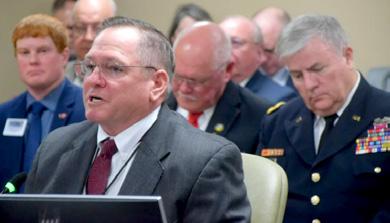
Pork Producers Recognition Banquet
Chad Schooley, Vice President of the South Dakota Soybean Association and several soybean staff and board directors attended the SD Pork Recognition Banquet including SDSA directors Kevin Deinert, Jordan Scott, and Chad Nelsen, staff members Bonnie Dybedahl and Mark Berg, and special guest Dave Poppens and his wife, Charis.
It was a great event and well attended by pork producers with a lot of familiar faces in the crowd. The South Dakota Soybean Research and Promotion Council was recognized by the Master Pork Producers for their contribution to the pork industry.

6 Spring Issue 2023 SDSL INVESTING CHECKOFF DOLLARS
Chad Schooley
Clean Fuels Update
SDSRPC Director Tim Ostrem and SDSA Director Derrick Scott attended the Clean Fuel Alliance America Annual Conference and learned just how fast demand for biodiesel and renewable diesel is ramping up. Several companies have moved to lower carbon and therefore they will be looking to use more biodiesel in the future. They also learned about B100 and how this higher blend compared to B20 will really drive an increase in soybean oil demand.

USSEC America Sustainability Conference
The U.S Soybean Export Council held the America Sustainability Conference in Panama City, Panama. The conference was attended by approximately 100 people including SD Soybean Research and Promotion Council Directors Mike McCranie and Dawn Scheier. The featured speaker was the former President of Colombia, Alvaro Uribe Velez, who came to learn about how U.S. soy and agriculture practices can help Colombia.

SD Soybean Checkoff Sponsors SDSU Women’s Basketball Game
The SD Soybean Checkoff was recognized as a sponsor at the Jackrabbit Women’s Basketball game against Denver on Feb. 16, 2023.

HEALTH PLANS FROM PEOPLE YOU TRUST.
SAVE OVER 35%
TRUST GOES WITH THE TERRITORY HERE.
Introducing South Dakota Farm Bureau Health Plans, quality coverage for everyone, not just farmers. To get access to these savings, just join South Dakota Farm Bureau for $60 a year.
For a quote or to apply, visit:

Spring Issue 2023 SDSL 7
SDSRPC District 4 Director David Iverson and SD Soybean staff Bonnie Dybedahl
LiveWellSD.com
( YOU )
You’re where the rubber meets the road. And the engine. And the interior.

All soybean farmers, including you, are busy replacing petroleum with your soy oil. How? By pooling your resources through your soy checkoff. Learn how your soy checkoff is bringing tangible returns back to you and your operation at unitedsoybean.org/hopper.
Moving Soy Forward. Moving You Forward.
©2022 United Soybean Board [61977-24 9/22]
LETTER FROM THE EXECUTIVE DIRECTOR
 By Jerry Schmitz,
By Jerry Schmitz,
The mission of the South Dakota Soybean Association (SDSA) is to improve the competitiveness and profitability of South Dakota soybean farmers through policy and education. SDSA works to ensure soybean producers have unencumbered freedom to farm by engaging at the local, state, national and international levels, addressing crop insurance, environmental regulation, land use, wetlands, land and estate taxation, Waters of the United States (WOTUS), pesticide use, facilities funding for research, livestock permitting and many other issues that directly impact family farms and ranches.
SDSA works with our Congressional delegation to build bridges literally and figuratively. Infrastructure funding for bridges, rail, roads, and river and dam maintenance is essential for us to move South Dakota soybeans across the world. International trade agreements provide symbolic bridges that allow South Dakota soybeans to move freely into other countries without protectionist bans or tariffs.
SDSA also actively assists and informs crop and livestock producers in many other ways. They have partnered with the Natural Resources Conservation Service (NRCS) to bring farmers the most current information related to soil health practices. The goal is to provide producers with information about practices that can be both environmentally and economically beneficial. A list of choices for producers that fit their operation and the conditions in their fields.
The mission of the South Dakota Soybean Research and Promotion Council (SDSRPC), the Soybean Checkoff, is to enhance opportunities for South Dakota soybean farmers by investing checkoff dollars into marketing, research, education, and promotional initiatives.
SDSRPC is constantly looking for opportunities that increase demand for soybeans and soy products domestically and worldwide. Demand for meal and oil drives the on-farm price of soybeans. Today 70-80% of our soybeans leave the state. We have been cultivating relationships with buyers in countries worldwide to diversify our portfolio of purchasers.

New uses developed through checkoff-supported research are also driving demand for soybeans. Soy-based motor oil, foam in car seats, asphalt and concrete road sealants, home insulation, dust suppressants, artificial turf, running shoes, bioplastics, paint and grease/lubricants are a few of the over 1000 uses for soy on the market today, and there is research nationwide to develop even more uses.
Research funded by a joint venture between the soybean checkoff and Goodyear Tire and Rubber resulted in soybean oil replacing petroleum in tires. The tires are more flexible in cold weather and have better grip. The company recently announced a new tire composed of soybean oil, rice husks, and pine resin has passed regulatory testing for road use.
Your soybean checkoff was responsible for initiating the biodiesel industry, but that was just the beginning. Through continued research, a new type of diesel called “renewable diesel” was developed. Where biodiesel is a mixture of soy and petroleum, renewable diesel can be made from 100% soy oil. Even more exciting are the new sustainable aircraft fuels made from 100% soy oil. For the first time ever, soybean oil demand has become the driver of the price of soybeans.
SDSRPC and SDSA working in tandem, create a synergy that paves the way for your success and leverages your checkoff dollars to drive demand, increase the value of your soybeans and make growing them more profitable and sustainable now and for future generations. Working together, listening to your interests and concerns, and keeping our eye on the prize will guarantee that we all have a very bright future.
Spring Issue 2023 SDSL
SDSOYBEAN.ORG
ALWAYS JUST A CLICK AWAY FROM THE LATEST SOY RELATED NEWS AND UPDATES. STAY UP TO DATE WITH US AT:
SOY TOPICS
PROGRAMS & EVENTS NEWS & MEDIA LEGISLATION AND MUCH MORE
JERRY SCHMITZ Executive Director of the SDSRPC and the SDSA
Executive Director of the South Dakota Soybean Research and Promotion Council and the South Dakota Soybean Association
INVESTING CHECKOFF DOLLARS INVESTING CHECKOFF DOLLARS INVESTING CHECKOFF DOLLARS
WAYS TO PROTECT YOUR SOYBEAN CROP FROM DROUGHT 5

Even though overall precipitation in South Dakota is high so far this winter, much of the state still remains designated as between D0 (abnormally dry) to D2 (severe drought) as of January 19, 2023, according to the U.S. Drought Monitor. Snow and rainfall totals over the next few months prior to planting season will be critical to adequate soil moisture levels. And then, of course, how much rainfall we get throughout key periods of the growing season will also play an important role in attaining yield potential.
But if there’s anything predictable about the weather, it’s that it’s unpredictable.
THINK PROACTIVELY ABOUT DROUGHT
Some things will forever remain out of your control. What you can do, however, is safeguard your operation as best you can against the effects of drought and moisture-deficient conditions.
Here are five things to look at to better prepare yourself for whatever weather conditions come your way:
INVESTING CHECKOFF DOLLARS
1. SEED SELECTION
It’s important to take a variety’s ability to withstand dry growing conditions and drought into account during your seed selection process. “The best management practice starts with seed selection,” says David Karki, SDSU Extension Agronomy Field Specialist. “Genetics play a huge role.”
Your seed dealer or certified crop advisor (CCA) can provide insight into the right varieties for your particular conditions and growing considerations. You can also tap into SDSU Extension’s Crop Performance Testing data for university trial results that offer a transparent comparison and contrast between varieties.
“Seed companies will send their varieties to test and compare with other genetics,” explains Karki. “Our job is to plant, grow and harvest that see and then analyze the data. We publish that data every year on our website.”
It should also be noted that through their checkoff, soybean growers are currently funding research efforts to develop increased drought tolerance in soybeans. Such innovation could help stabilize yields and provide more flexibility to producers growing soybeans in moisture-deficient conditions.
2. SOIL MANAGEMENT PRACTICES
Soil management is increasingly touted as one of the most valuable tools in a producer’s toolbox. Among the many benefits of soil management is its capacity to aid moisture retention.
Start by examining your tillage strategy. Conventional tillage will bring moisture-rich soil to the surface, where evaporation can dry out the topsoil and exacerbate your challenges. That’s one of the reasons agronomists have placed increased emphasis on no-till and min-till practices — particularly when faced with the effects of drought — that will help retain much-needed moisture in your soil.
Sticking to a consistent crop rotation can also be an effective soil management practice to ward off the effects of drought and drought-like conditions.
3. COVER CROPS
Building on these soil management practices, incorporating cover crops can also be beneficial in your efforts to mitigate risks associated with drought by improving soil properties.
SDSU Extension offers numerous resources for growing cover crops. Given the typical winter in South Dakota, Karki recommends cereal rye as a particularly effective cover crop to plant after corn and ahead of soybeans.

“Cereal rye has been a go-to cover crop,” says Karki. “It works like a charm.” If dry weather patterns persist into the spring, however, Karki advises terminating the winter annual early so that it does not consume too much moisture from your soil prior to planting soybeans.
4. PLANTING DATE
Your planting date can also impact how well your soybean crop manages dry growing conditions. Planting earlier in the season when more moisture is typically more available gives soybean plants a better opportunity to establish healthy root development and more effectively withstand dry periods.
Image Source: SDSU
Image Source: SDSU Extension
Be mindful of factors such as soil temperature as well as the risk of a late frost, but early planting can be an effective strategy for managing against the potential of drought conditions.
5. RISK MANAGEMENT
As noted earlier, weather conditions are completely out of your control and can be rather unpredictable. That’s why, in addition to the aforementioned on-farm tactics, you need to hedge against loss through a combination of crop insurance and grain marketing strategies.
Karki notes that SDSU Extension’s team of experts includes a business management field specialist who is available to provide consultation and other resources. You might also have a trusted local advisor who can provide support.
Regardless, tap into whatever resources you have available to make informed business decisions for your operation when managing risk.
DEVELOPING MORE RESILIENCE
Drought can take a serious toll on your soybean yields and overall profitability.
And while nothing can entirely insulate your soybean crop, hopefully putting some of these ideas into practice can help your operation develop more resilience against the effects of drought.

SOURCES:
U.S. Drought Monitor: www.drought.gov/states/south-dakota
Crop Performance Testing: extension.sdstate.edu/tags/crop-performance-testing
Resources for growing cover crops: extension.sdstate.edu/sites/default/files/2020-03/S-0004-05-Soybean.pdf
Spring Issue 2023 SDSL 11
Growth of winter cereal rye cover crop. The field was seeded the previous fall at the corn physiological maturity stage.
Extension
WHY SHOULD SOYBEAN FARMERS CARE ABOUT THE SOUTH DAKOTA LEGISLATURE?
We all know that our farm acres are owned and operated by fewer farm families. At the same time, the production from those acres continues to rise along with our livestock production. This not only has an impact on agriculture, but it impacts agriculture’s representatives in elected offices such as our legislature, mayors, city councils, and county commissions.
Our numbers decline in farm country while our cities continue to grow. South Dakota has 35 legislative districts, each with one Senator and two Representatives.

Here is what it looks like for our largest cities:
● Brandon, District 2-one farmer (three legislators)
● Aberdeen, District 3-no farmer (three legislators)
● Brookings, District 7-no farmer (three legislators)
● Sioux Falls, Districts 9,10,11,12,13,14 and 15-no farmer (21 legislators)
● Yankton, District 18-no farmer (three legislators)
● Mitchell, District 20-one farmer (three legislators)

● Huron, District 22-one farmer (three legislators)
● Pierre, District 24-one rancher (three legislators)
● Dell Rapids, District 25-one farmer (three legislators)
● Rapid City, Districts 30, 32, 33, 34, and 35 – no farmer (15 legislators)
● Spearfish, District 31-no farmer (three legislators)
Looking at the entire legislative body of 105 people, there are a total of 11 legislators who claim agriculture or ag business as their occupation. That leaves 94 who are not in agriculture. In other words, 89.5% of our legislature is NOT involved in agriculture,
yet makes decisions every year that directly impact your industry.
We are fortunate to have strong, recognized, and respected ag organizations like the South Dakota Soybean Association working for you in the legislative process. That is a big part of why we can keep bad legislation from passing that would have a negative impact. We are fortunate to have a few farmers in the legislature because the urban legislators will often, but not always, look to them for advice on ag issues.
So, what do we do? It becomes more imperative every election that ag organizations support people who support ag. It is incumbent upon ag to reach out to urban legislators and educate them on what you do in your day-to-day farm life.
● Show them what modern agriculture is and what it costs to plant and harvest that crop.
● Teach them about the value-added components of your industry brought by your checkoff investments in yourselves, your crop, and your future. Hungry for Truth, South Dakota Soybean Checkoff’s consumer initiative is an excellent example.
● Call an urban legislator and invite them to your farm, take a ride in the combine or tractor, show them your hog or dairy barn, and bring them into your farm life. Invite their questions and offer to be a resource for helping them understand modern agriculture. They will appreciate it and remember it.
It is our responsibility to be transparent in our industry.
Thank you for your support in Pierre during our Legislative Session.
12 Spring Issue 2023 SDSL
By Lorin Pankratz, Lobbyist for the South Dakota Soybean Association
SOYBEAN LEGISLATIVE REPORT
LORIN PANKRATZ
Super SproutS S
Meet Sprout, the masCot for the super sproutS educational program. Super SproutS aimS to provide at home educational activities for chilDren of all ages. Sprout’s goal is to enSure everyone knowS about the superpowerS of SoybeanS!
ScavenGer hunt
In South Dakota, animals are the #1 customer of soybeans! With the help of an adult, visit sdsoybean.org/topics/animal-ag to read about animal agriculture, take virtual tours, and complete the questions below.
1. Animal agriculture represents the number one customer of soybeans, both at
2. ___________________ is the husbandry of aquatic animals in a controlled environment for the purpose of food production.
3. Researchers at SDSU are aiming to increase _________ in aquaculture diets.
4. South Dakota _________ herds consume an average 51,000 tons of soybean meal.
5. South Dakota dairy cows produced approximately ________ million gallons of milk.
6. There are ______ licensed dairy farm families in South Dakota.
7. These animals consume the most soybean meal. ________________
8. Hog farmers provide the best possible _________ for their animals.
9. South Dakota _________ consume an average of 47,000 tons of soybean meal.
10. _____ ________ in the state consume 15,000 tons of soybean meal.
Want more fun? show us your anSwerS!
Soybean Swag Giveaway


With your parents help, complete this page and send a photo to mkessler@sdsoybean.org or post a photo and tag @SDSoybean on Facebook. You can also mail your completed page and contact information to SD Soybean at 5000 Broadband Ln. Suite 100, Sioux Falls, SD 57108. One participant with a completed page will be sent a super special soybean item! Entries must be recieved by June 1, 2023 to be eligible.
have fun anD be sure to enter!
_______ and _________.
INVESTING CHECKOFF DOLLARS
UNDERSTANDING CARBON CREDIT PROGRAMS FOR SOYBEAN PRODUCERS

Carbon programs for farmers and ranchers have gained momentum in the past couple of years.
Today, soybean producers have an increasing number of market-driven opportunities to cash in on certain soil management practices, including the following:
● Reduced tillage
● Fertilizer conservation
● Improved grazing
● Diversified rotations
● Planting cover crops
These practices initially fetched anywhere from $10 to $20 per carbon credit — representative of 1.1 tons of carbon dioxide equivalent (CO2e) — but that price appears to be increasing in value as market demand continues to grow.
HOW CARBON CREDIT PROGRAMS WORK
Whether you’ve already signed a carbon credit contract or you’re just evaluating your options, it’s helpful to understand this relatively new and everevolving landscape.
Offered by the major ag retail companies as well as a growing number of tech startups, carbon credit programs typically work with an established carbon offset registry to verify and purchase credits from participating farmers.
Soil sampling is quite often built into this process, although quantity and frequency will vary by program. Most carbon credit programs also provide an online platform for producers to manage their acres and document on-farm practices.
After compensating a producer, the company is then able to sell these verified carbon credits on the market. The most common buyers, larger corporations, purchase carbon credits in an effort to offset their own carbon footprint and either satisfy consumer demand for a higher sustainability commitment or comply with governmental regulations (or, in many cases, both).
WHAT TO KNOW BEFORE SIGNING UP
The opportunity to earn additional income on land you farm is a huge upside, but you want to make sure you know what a particular carbon credit program entails.
When evaluating carbon credit programs, you should ask yourself a few key questions:
● What practices will you need to implement on your farm?
● What kind of investment, in both time and money, will the above practices require?
● How will these practices benefit your farm agronomically?
● How much data are you required to share? Are you willing to share it?
● What are the terms of the agreement? How long does it last?
● If credit values increase, will you receive additional compensation?
Also, there are many different comparison charts available online to help you discern what distinguishes each of the major programs and which might be the best fit for your operation. Doing homework upfront can position you to make the best decision about participating in a carbon credit program.
ADDITIONAL CARBON CREDIT PROGRAM RESOURCES
As noted earlier, the market for carbon credits continues to evolve — as do the programs that can help operators tap into its economic benefits.
Both SDSU Extension and your county NRCS office have soil management resources available and can provide you with additional insight into various carbon credit opportunities.
Another resource is the Ecosystem Services Market Consortium, a non-profit organization funded in part by the United Soybean Board (USB) to help advance markets that incentivize farmers and ranchers to implement soil management practices that benefit society.
14 Spring Issue 2023 SDSL INVESTING CHECKOFF DOLLARS
CHECKOFF SUPPORTED EXPORT PROMOTION PAYS OFF

U.S. soybean growers depend heavily on foreign sales of their crop. The US Soybean Export Council (USSEC) is in business to represent U.S. growers to customers all over the globe. USSEC Chairman Doug Winter makes clear that the organization doesn’t directly sell anything to export buyers. Instead, he refers to the organization as an “enabler.”

“We add a lot of expertise in the livestock sector,” said Winter, during an interview. “Our strategic plan is to differentiate U.S. soy as a superior supply, or a superior source of soy products and to elevate that soy to the different customers around the world. And then we also work in providing market access to all the different import/export markets around the world.”
USSEC, according to Winter, does a lot of work in aquaculture and livestock nutrition counseling as well as helping nutritionists determine the most efficient rations in milling and feed formulations. “We do a lot of work just helping to find better uses, new and better ways to use soy products in different livestock rations and also in the human nutrition side of things,” he said.
Resulting in part from the efforts of USSEC farmer/leaders and staff, the bulk of what Winter grows on his southeastern Illinois farm is exported. After delivery to an elevator, that journey begins with a barge ride down the Ohio River, at which time the shipment is made part of the roughly 60 percent of the U.S. soybean crop that’s exported. Winter says he and other farmers that grow for the foreign market benefit from the mission of USSEC.
“I think that what we do at USSEC has improved our exposure. We’ve done a lot of work with China for the last 40 years, but we also do a lot of work with emerging markets around the world, in different parts of the world, Sub-Saharan Africa, South Asia, Southeast Asia, all those different areas. And so that’s what we’ve looked at, at diversifying our markets to sell the crop that we export to a number of different areas of the world,” said Winter. “So, I think it’s helped in our demand a great deal as American farmers, particularly in my part of the country.”
INVESTING CHECKOFF DOLLARS
U.S. FARMERS DELIVERING SUSTAINABLY GROWN GRAINS
By Kurt Lawton
The term ‘sustainability’ quickly became a discouraging word among farmers when leaders began touting its need in agriculture.
“It put a burr under my saddle and caused a lot of us to get defensive,” says South Dakota farmer Mike McCranie, a longtime leader who sits on various soybean boards. “When you’ve farmed for 40 years, on some land my great-grandfather homesteaded 142 years ago, and made vast productivity improvements, you get defensive when someone says you need to be more sustainable,” he says.
But given greater perspective and acknowledgment that global grain buyers import more than half of U.S. soy grown, McCranie believes this continued conservation focus benefits his sons and all farmers on the journey of continuous improvements.
HISTORY OF CONTINUED IMPROVEMENT
Taking a step back, McCranie pays tribute to the early conservation pioneers, those farmers who helped push Congress to establish the Soil Conservation Service (now known as National Resources Conservation Service - NRCS) in 1935. The Great Plains ‘Dust Bowl’ pushed conservation forward to address soil erosion problems. Then the USDA established Soil Conservation Districts in each state to lead local efforts.
In South Dakota, McCranie cites his wife Monica’s grandfather, Claremont farmer Frank Feser. He helped push for state and national conservation needs in the 1940s and 50s as an organization member and then President of the South Dakota Association of Soil Conservation District Supervisors.
“In the 1930s, it got so dry, and so much land blew into what looked like sand dunes and a desert, even in South Dakota,” McCranie says. “So Feser began land changes like planting trees, shifting from fall to spring plowing, keeping cover on the land and listing corn—all to get a big jump on wind erosion. Today, you’d never know it was the same field we continue improving. That is progress and sustainability. He also pushed for similar efforts to control river and stream flooding within watersheds to reduce water erosion.”
GLOBAL SUSTAINABLE DEMANDS
McCranie, who just returned from a U.S. Soybean Export Council (USSEC) board meeting, emphasized the importance of sustainability among global grain and meal buyers.
“Currently, 60% of our exported U.S. soybeans are sold and accompanied by our U.S. Soy Sustainability Assurance Protocol (SSAP) certificates,” McCranie says. “Our recent meeting hosted
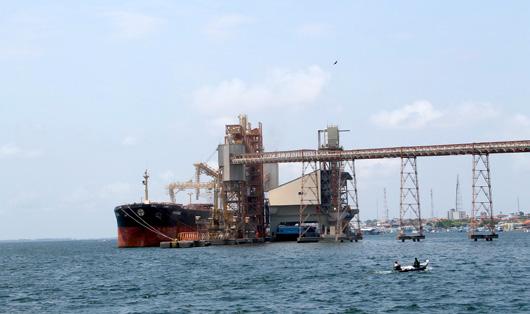
Central and South American buyers who are very concerned about sustainability issues, which is why they are choosing U.S. soybeans.”
The 10th anniversary of the checkoff-funded SSAP program proves our global buyers want US soybeans with proven sustainability. “Our first year (2014), we shipped 7,000 metric tons with SSAP certificates, and in 2022 we exceeded 40 million metric tons,” says Abby Rinne, USSEC Sustainability Director.
“Interest has really grown among our customers who want soybeans grown in a sustainable manner,” Rinne says. “The program was built initially to satisfy questions from European countries. But sustainability is top of mind for all international markets now. And this program really showcases that U.S. farmers are producing a sustainable product that continues to improve.”
ACHIEVING SUSTAINABILITY CERTIFICATION
USSEC determines the amount of soybeans that are sustainable using an aggregate approach. First, they look at the number of farmers in the U.S. Farm Program (making them subject to audit). Second, the organization calculates compliance with USDA audits (20,000/year across 2,200 offices = average is 97% compliance). Third, calculate total soybean production in a year.
“This allows us to determine how much of the crop can be verified as sustainable with the SSAP program,” Rinne says. “Then we have an online database where exporters can issue certificates for their exports. And in 2022, we began allowing transferable certificates.”
To benefit the buyer’s supply chain, an SSAP certificate can be transferred four times. So, for example, a European feed mill buyer could crush them, sell to a hog farm which then sells meat to a processor/retailer—all of whom can report that the feed contained sustainable U.S. soy.
16 Spring Issue 2023 SDSL INVESTING CHECKOFF DOLLARS
“U.S. farmers take great care for their land and natural resources just by adopting conservation practices and showing continual improvement,” Rinne says. “So, a combination of these practices and compliance with laws and regulations really help set the U.S. soybean production industry apart from our competitors.”
JUDGING SUSTAINABILITY PROGRESS
McCranie, who farms near Claremont with his wife Monica and two sons Matthew and Mitchell, says Mother Nature was their driver to become more sustainable. “It was enlightening to know that we are SSAP sustainable by adopting no-till and conservation tillage that adds residue to keep soil protected from weather extremes while conserving moisture to reduce drought,” he says.

Continued improvement through equipment and genetics technology helps McCranie move toward his goal of passing on improved land to the next generation. “I’m excited to see my technology-loving sons continue to advance the farm and ensure we grow our sustainability,” he adds.
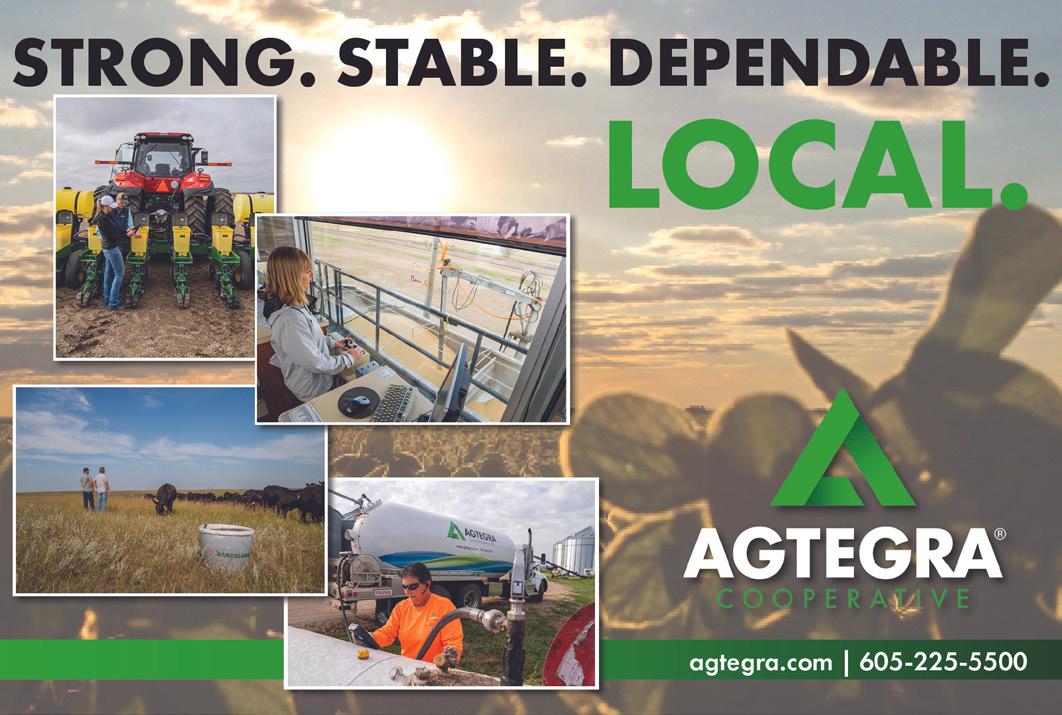
To learn program details, read the latest U.S. Soy Sustainability Assurance Protocol—Version 3.2. Directive 4 highlights continuous improvement practices and environmental protection control measures and regulations. “It highlights all of
the valuable programs from NRCS that support development and innovation for sustainable soybean production,” Rinne says.
So, the next time you hear the term sustainability, McCranie and Rinne hope farmers think in terms of the fact that the customer is interested, and sustainability grows the U.S. share of export markets. “By continuing along a sustainability journey—as we have since the Dust Bowl days—farmers can ensure they’re in operation from one generation to the next,” Rinne adds.
Find U.S. Soy Sustainability Assurance Protocol Version 3.2: www.usses.org/wp-content/uploads/2022/08/SSAP3.2_AMSApproved-6.8.22.pdf
Spring Issue 2023 SDSL 17
Mike McCranie and his family
THE MICHALSKI FAMILY: BOOST FARM SUCCESSION THROUGH SOIL HEALTH PRACTICES
 By Kurt Lawton for SD-USDA NRCS and SDSA Soil Health Initiative
By Kurt Lawton for SD-USDA NRCS and SDSA Soil Health Initiative
It’s hard to imagine how turning a farm’s first 80-acre cropland field into a variety of monoculture grass pastures in 1999 could eventually lead to a son returning to the farm.
It certainly wasn’t a vision seen by Willow Lake, SD farmer/ranchers Darin and Jessica Michalski as they embarked on developing their business in the late-90s. But like all farmers and ranchers with kids (or without), it’s a joy to see a new generation continue a legacy.
Trial and error, program assistance, peer education and perseverance helped build a growing resilient business over the last 24 years. The Michalskis cited several key factors that drove success over time:
● A different and open whole-farm mindset.
● Cropland and grassland diversity.
● Soil focus and no-till cropland shift.
● Youth involvement.
● Honest communications.
“The most important thing my husband and I have done to contribute to a successful ranching operation is really thinking from a different mindset,” Jessica says. “There is a big value in thinking beyond what is growing above ground, thinking about the health of our soils, water infiltration rates, crop diversity on the landscape—truly thinking about a whole system dynamic beyond beef, soybean or corn bushels produced per acre,” she adds.
18 Spring Issue 2023 SDSL
Soil HEALTH
Cutler, Jessica and Darin Michalski
CONSTANT LEARNING, PROGRESSING
Jessica and Darin grew up farming, graduated college and began adapting crops to fields. “I gained a rotational grazing mentality when my parents converted less-desirable cropland into divided pastures by seeding both cool and warm season native grasses,” Jessica says. “This really helped when Darin and I got married as he also wanted to focus more on grassland and soil health.”
The ranch has improved thanks to great partnerships using both financial resources for infrastructure projects and conservation assistance programs from NRCS; U.S. Fish and Wildlife; South Dakota Game, Fish and Parks and other organizations. In addition, Jessica helped further diversify the operation through her employment with South Dakota NRCS since 2003, currently helping farmers as State Resource Conservationist.
Like sponges, Jessica and Darin’s three children (Cutler, Kasey and Shay) have helped with crops and cattle from an early age, watching and absorbing farm changes and improvements. Their oldest son, Cutler, a senior at South Dakota State University, was raised helping interseed pastures with native grasses, removing thistles and moving grazing cattle by measuring grass. “It taught me the importance of a grazing and soil health mentality, realizing the benefit of taking half and leaving half the grass, plus the fun of moving a lot of cattle,” Cutler says.
OPEN COMMUNICATIONS ARE CRITICAL
The Michalski’s saw Cutler’s deepening ranch interest during high school. Yet Jessica knew his success with math could lead to an engineering or technology field, so they didn’t want to push his decision to return. “When we started talking about college his junior year of high school, he told us he wanted to come back to the ranch after attending SDSU.”

After many more open conversations and financial planning for a future ranch addition, Cutler began building his economic value by obtaining FSA financing to purchase 30-head of bred heifers before he started at SDSU. The timing worked well as nearby ranchers contacted him to offer pasture rental. “They saw how he helped us care for and improve pastures, which these landowners desired,” Jessica says.
Cutler appreciated how the ranch continued to experiment during his high school years. “We were increasing our intensive grazing among smaller paddocks, measuring and recording data for the CSP program,” he says. “It was a valuable learning experience to understand what the grass was capable of when you let it heal itself and allow the soil to work for you.”
In 2020, Cutler interned with the South Dakota Soil Health Coalition, gaining additional knowledge and understanding of how other farmers adopt soil health practices. “He has definitely bought into the value of soil health, helping us to continue improving our land,” Jessica says. “We’ve instilled the value of learning from peers by attending pasture walks, Grassland seminars, and a tour of Gabe Brown’s operation. Cutler has also helped us share our experiences with peers during grassland and soil health conferences.”

SOIL HEALTH DRIVES FINANCIAL HEALTH
Bringing on a family member started becoming viable after seeing the benefits of years of pasture and cropland improvement. Over time, improved water infiltration and soil health have extended the grazing season with greater stocking rates.
“We’ve probably increased our grass production by 25% by adding those warm season grasses we were missing before,” Jessica says. “That has helped us to ensure we have adequate forage production even in a drought year. And this success spilled
Spring Issue 2023 SDSL 19
Jessica, Darin and Cutler Michalski Kasey, Shay and Cutler
over into more changes with crop ground.”
Cropland diversification to their soybeans and corn enterprise has further entrenched no-till success through healthier soils and more revenue stream possibilities that fit well with a cattle operation. The Michalskis grow oats, alfalfa, hay millets, cover crops and pollinator habitat.
“We’ve made huge improvements to our bottom line,” Jessica says. “Crop yield bragging rights are not important to us. What is important is reducing our input costs thanks to implementing no-till and cover crops. We reduce our feed costs by grazing cover crops and crop residue from fall into winter. By improving grazing management, we’ve increased our carrying capacity. And we’re improving labor and management skills by adding Cutler to the farm,” she adds.
Darin and Jessica are proud to have their son return to the farm. “Right now, we’re set up to handle adding Cutler on a salary basis, plus he has his cattle. Eventually, he will transition into the Michalski Cattle LLC,” Darin says.


The Michalskis have established a strong appreciation for the land, conservation and soil health practices, and the perseverance
needed to achieve business success. “We’re grateful to pass along land better than we started with, and really hope future generations continue on this path,” Darin adds. “It would be fun for my grandkids to have good land, soil and water – I guess that’s my main goal.”
To learn more details of the Michalski journey, watch the 2022 SD Soil Health Conference “Preparing for the Next Generation – Michalski Family”
YOU WILL ALWAYS BE CONNECTED TO YOUR GRAIN STORAGE. MONITORS YOUR GRAIN FROM THE PALM OF YOUR HAND. SIMPLE AND ACCURATE. FREE TECH SUPPORT FOR LIFE.




20 Spring Issue 2023 SDSL Soil HEALTH
PROTECTION IN THE PALM OF YOUR HAND.
There is nothing more important than protecting your grain harvest. Tri-States Grain Conditioning systems will help you remotely monitor your grain, save on energy costs and improve your overall grain storage.
ANNIVERS AR Y GRAIN CONDITIONING MADE IN THE USA TSGCINC.COM • 712.336.0199
with your mobile device to watch the video. Or visit bit.ly/2022-SDSHC-Conf_Michalski-Family
Scan
FARMER-LED GROUPS WORK FOR HEALTHIER SOILS

The Soy Checkoff, Pork Checkoff, and National Corn Growers Association are collaborating for the sake of conservation. The partnership Farmers for Soil Health (FSH) has created a farmer-led cover crop program that advances the use of soil health practices to improve profitability and meet sustainability goals. A $95 million USDA grant is helping to launch the program to advance the adoption of cover crops and conservation tillage, according to Jack Cornell, director of sustainable supply for the United Soybean Board (USB). “The overall goal is to get to 30 million acres of cover crops by 2030, but the really exciting piece is the technical assistance piece that we were able to obtain so that we have about $15 million that is geared towards enhancing state-level commodity programs around conservation,” said Cornell, in an interview with the South Dakota Soybean Network, “so there’s that to help farmers implement these practices.”
The other part of the FSH effort is to enable farmers to drive sustainability improvements with support from industry and supply chain partners. “As farmers raise commodities under these sustainability-type efforts, looking at notill, cover crops, reduced tillage, we’re actually bringing buyers on the back end,” said Cornell, “creating enhanced profitability for growers that are growing commodities raised under these practices.”
“Cover crops improve soil structure, help recycle nutrients, reduce soil erosion, increase the soil’s water holding capacity and sequester carbon.

This reduces the environmental footprint of corn, soybeans and pork production because corn and soybeans are the two primary ingredients fed to pigs,” said Dale Stevermer, Minnesota corn, soy and pig farmer, quoted in a news release issued by the USB. “It can take a few years to learn how to best utilize cover crops, and this Farmers for Soil Health program will help farmers accelerate that learning curve.”

There are three years of declining cost-share payments that are to be offered to 8,000 to 10,000 farmers, helping them transition to cover crop usage on 1.44 million acres of corn and soybeans, according to the USB. “These funds can help with building out some of your infrastructure on the farm that can help with resilience with wetter springs [and] dryer summers,” said Cornell. “Finally, we’re getting some financial assistance to the farm level to help farmers implement tools for them to do these things.”
FSH will work with data insights and publishing company DTN to develop a digital platform using satellite imagery, according to the USB, allowing farmers to receive an “eco-score” for corn and soybeans produced with cover crops and conservation tillage. “There will also be a lot of additional technical assistance pieces out there to help farmers navigate these waters as well, because there’s going to be a lot of programming, it’s going to come like a tidal wave,” said Cornell. “We want to make sure that there’s a technical assistance piece to help farmers figure out and navigate what program works best for them.”

Spring Issue 2023 SDSL 21
VISIT FARMERSFORSOILHEALTH.COM TO LEARN MORE. INVESTING CHECKOFF DOLLARS
SIOUX FALLS CHAMBER OF COMMERCE HONORS SOYBEAN FARMER/ LEADER

Scott, the immediate past president of the South Dakota Soybean Association, is the fifth generation farming 1,400 acres at Valley Springs, a few miles outside Sioux Falls. “We have been on this same ground for over 125 years and it’s kind of cool to see my boys running around the yard and climbing around on the equipment,” said Scott, reacting to the announcement of the award. “They enjoy it just as much as my dad and I do.”
Jordan’s dad is the American Soybean Association immediate past chairman Kevin Scott. The honor from South Dakota’s largest chamber of commerce is especially touching for Jordan and his family. “In a city like Sioux Falls, ag drives so much of the business, from processing all the way down to the restaurants and the shops and the stores,” said Jordan Scott, who has just been seated as a director from South Dakota on the American Soybean Association Board, taking the place of his father, who just reached the end of his term on that governing body. “Ag touches every aspect of that city, so to work closely with them and [to have] the relationships that we have, it’s exciting; it’s important to them and it’s important to us.”
Until recently, Jordan Scott has been busy with the South Dakota Soybean Association. He has been on the board of directors for five years and has served as president for the last two years. After high school graduation, he worked different jobs in Sioux Falls until the time was right for him to come back and farm full-time with his parents Kevin and Jannell. It’s Jordan’s passion for being the fifth generation involved in his family’s farming enterprise that makes the Scotts remarkable, according to Brooke Hendrickx, the manager of the Greater Sioux Falls Chamber of Commerce Agribusiness Division.
“They do it because they love it, they don’t do it because it’s a job,” said Hendrickx, about the Scott family. “I think that’s another thing that really sets them apart. They don’t care about the paycheck that’s coming at the end of the day, they do it because it’s something they love and something that’s been instilled in them from previous years.”
Jordan, his wife, Samantha, and sons, Lincoln and Dane will be officially honored at the annual Mayor’s Round-Up and Sale of Champions on January 27, which is an annual feature of the Sioux Empire Livestock Show.

22 Spring Issue 2023 SDSL
INVESTING CHECKOFF DOLLARS
The Jordan Scott family is the Greater Sioux Falls Chamber of Commerce 2023 Farm Family of the Year.
Jordan Scott with his father, Kevin (left)
Jordan, Samantha and sons, Lincoln and Dane
RIVER LEVEL HAS IMPACT ON SHIPPING CAPACITY

Inadequate precipitation has resulted in the Mississippi River being lower than normal, reducing its shipping capacity. South Dakota soybean growers depend primarily on rail transportation to the West Coast to get their soybeans to outbound ports, but shipping issues on America’s inland waterway system affect all U.S. growers.
“There’s nothing like the inland waterway system in moving high-volume freight long distances in an economical manner. That’s what’s been one of the contributing factors of our success over the years,” said Mike Steenhoek, executive director of the Soy Transportation Coalition, calling that the good news. On the other hand, the bad news is that a dryer-than-normal period has resulted in an urgent need for constant dredging to keep the river passable.

“Throughout the course of this last year, we’ve had a lack of precipitation, and it’s manifested itself with low water conditions on the inland waterway system, particularly the Mississippi River south of St. Louis,” said Steenhoek, adding that it has an impact in shipping in a couple of ways, affecting channel width and channel depth.
“Every time you have a one-foot reduction of water for that navigation channel, that means you’re putting 5,000 fewer bushels per vessel, and for an individual barge, that can easily accommodate 50,000 to 60,000 bushels a 5,000 [bushel] reduction is quite significant,” he said. “What we’ve had on the lower Mississippi River, you can normally go to 12 feet of water depth. Now we’re seeing 9 feet, so now all of a sudden multiply that 5,000 bushels times three, you’re seeing easily 15,000 fewer bushels per barge.”
Fall and winter precipitation has provided relief, but the river is still lower than normal, limiting not only the number of bushels per barge because of shallower water, but also the number of barges per tow because the channel is narrower. “Normally, you can get 30, 35, 40 barges all attached together, now the maximum is 25,” said Steenhoek. “The lack of channel depth, the lack of channel width, the economics have been profoundly changed, and that’s certainly had an impact on our competitiveness.”

Spring Issue 2023 SDSL 23
INVESTING CHECKOFF DOLLARS
SIOUX FALLS’ ELAINA LANSON SEES WHAT FARMING AS A FAMILY TRULY MEANS
Having open conversations about food and farming with South Dakotans and the farmers who grow it is what we do. In fact, that’s what Hungry for Truth is all about.
We had an exciting opportunity to connect Elaina Lanson of Sioux Falls, S.D. with farmer Chad Schooley of Castlewood, S.D. to chat about farming, tending to cattle, and what a day on the farm looks like for his family.


Below, Elaina is sharing her perspective of her recent South Dakota farm visit.

Family is usually at the core of every successful farm, and I found this to be especially true during my visit to Cabin Still Cattle Ranch in Castlewood, South Dakota. Five generations have worked the land and cared for the cattle here over the years, and learning how each generation used their expertise in their approach to farming made it really special.
During my farm tour, I had the privilege to spend the day with Chad Schooley, the First Vice President of the South Dakota Soybean Association board and the fourth member of the family tree to run the farm, and meet his father and son.
The first thing we did was mix the food for the cattle and take it out to their troughs in the field. During our tractor ride out to the fields, Chad told me one of the biggest things he focuses on is sustainability, a key lesson he learned from his father.
Chad explains the reason they have the farm today is because his father persevered through the 1970’s and 80’s when the country saw the cost of fuel and seed go up, while the value of the land went down. The land value helps farmers receive loans to operate, and when that diminished, it resulted in many farmers losing their land. His dad worked hard to take good
24 Spring Issue 2023 SDSL INVESTING CHECKOFF DOLLARS
care of the land they had and did not try to increase their acreage during the adverse times.
I could tell how proud he is of his father by the way he told me the story. As we head back towards the silos, Chad smiles when he tells me that even in his 80’s his dad is still on the farm every day.
Taking his father’s methodical approach into account, Chad continues to expand the farm in a sustainable way, which he’s been doing since the 90’s. The health of the land is of the utmost importance, and with the knowledge and technology they have, I can see how they can keep the land at its best.
Chad showed me that in each tractor, planter, and combine, there is an electronic system that tells farmers exactly what, where, and how much to plant. All of the information is sent to iCloud, so they can measure year to year and soil conditions, which I thought was truly remarkable.
Using these systems Chad successfully produces soybeans, corn, oats, alfalfa, cover crops and more throughout the growing season. Even the grinder mixer (which I learned is the machine we used to mix the cattle feed together) uses a computerized system to weigh each ingredient, mix and distribute the correct amount of food to the cows.
When Chad showed me the different ingredients, he told me that 5-10% of the crops they grow go to feed their cattle. Knowing that they have 500+ cows, goes to show how much the Schooley farm produces, and further shows how important it is to take good care of the soil.
Chad says this where we can really look to the future. He said his son Beau is great with the technology and plays a huge role in applying the technology to how they farm. He explained the sky’s the limit for the next generation in terms of implementing sustainability in farming.
With each generation bringing a different quality to their farming style, Cattle Still Cattle Ranch has every base covered. With no days off, you’ll see the motivated trio on the farm every day, nurturing their crops and tight knit relationships.

To find more Hungry for Truth
Ambassador farm visits, go to hungryfortruthsd.com Ambassador
Check out our last edition’s Ambassador Pairing where Vaney Hariri, Co-founder of 3D Think Solutions, joins Jordan Scott, a farmer from Valley Springs, S.D., to talk about generational farming, the meaningful work farmers do, Jordan’s passion for sharing experiences via YouTube, and much more.

Connecting and giving real people access to a real South Dakota farm to learn, observe, ask questions, engage with farmers, and see first-hand how South Dakota farming operations go round.

Read all our Ambassador Pairing stories online at hungryfortruthsd.com/ ambassador-program Or scan QR code

Spring Issue 2023 SDSL 25
Program
A good, deviled eggs recipe is among the most classic favorites for the holidays, parties, and gatherings. Even though South Dakota weather isn’t quite on board yet, we are ready for spring to come. To get into the mood though, we made these savory bacon deviled eggs!

INGREDIENTS

12 eggs
1/4 cup mayonnaise
1/4 cup cream cheese
2 tsp Dijon stone ground mustard
2 tbsp pickle juice
INSTRUCTIONS
2 tbsp pickle relish
1 tbsp hot sauce
1/2 tsp Paprika
Bacon crumbs (to top)
1. Fill a pot with 1/2 inch of water and boil. After the water comes to a boil, turn the heat off and add the eggs to the pot. Turn the heat up to medium-high, cover the pot, and cook for 11 minutes. Place cooked eggs in a bowl of cold water to cool for 3 minutes.
2. Peel the eggs and then cut them in half, lengthwise. Remove the yolks and add to a bowl. Save the egg whites for later.
3. Smash the yolks with a fork. Add the rest of the ingredients and mix until smooth.
4. Spoon the mixture into a piping bag and fill the holes in the egg whites with the mixture. Top with bacon crumbs.
POSSIBLE VARIATIONS:

We would say our deviled egg recipe is top-notch, but you can make it sweeter, spicier, or more savory to match your preference. Some variations that we would suggest include adding additional ingredients like chives, shallots, jalapeno, or goat cheese.
WHAT’S SO “DEVILED” ABOUT DEVILED EGGS?
The term “deviled” comes from an 18th-century culinary term to describe spicy or zesty food. Deviled eggs are typically hardboiled eggs filled with mayonnaise, mustard, and a few other spices.
HOW TO MAKE THE BEST DEVILED EGGS?
The key to the best deviled egg is boiling your eggs perfectly. Make sure to follow the step-by-step instructions recipe to learn how long to boil your eggs!
FUN FACT:
Did you know that 700 million eggs are laid by chickens annually in South Dakota? Poultry is also the number one consumer of soybean in the country! So really the question should be: what came first, the chicken or the soybean? Soybeans are really involved in so many of our everyday foods and products!
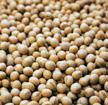


26 Spring Issue 2023 SDSL INVESTING
more recipes at hungryfortruthsd.com Prep Time: 15 mins | Cook Time: 15 mins | Total Time: 30 mins | Servings: 12
CHECKOFF DOLLARS Find
SOY-BASED FUELS HAVE A POSITIVE ECONOMIC IMPACT
Biodiesel usage in petroleum diesel fuel is growing. An updated study late in 2022 indicated blending of the renewable fuel is at a higher rate than it was three years prior to that. “We are producing about 5 percent of the on-road diesel heavy-duty transportation fuel that’s being used in the United States,” according to Paul Winters, public affairs director at Clean Fuels Alliance America. “Biodiesel and renewable diesel reached 3.1 billion gallons last year; that is 5 percent of the market here in the United States.”
Growth continues with even more demand for soy-based combustibles, partly because of diversification into the sustainable aviation fuels sector. “We are the only industry that is actually producing commercial gallons of sustainable aviation fuel today,” said Winters. “We look to grow [bio-based fuel production] to about 6 billion gallons within this decade.”

That makes a significant economic impact with even more on the horizon, which Winters says begins with the number of people on the payroll in processing and other industries.
“We are supporting 75,000 jobs around the United States [and] we are generating about $23 billion in economic activity,” he said. “If we reach our goal of 6 billion gallons, that’s going to increase substantially; 187,000 jobs in the United States and more than $60 billion in economic activity.”
While the latest study indicates biodiesel growth, Winters says it also indicates an acceleration in biodiesel’s impact on the U.S. economy. “The rate of economic activity per 100 million gallons back then was about $780 million. Today, it’s more than $1 billion for every added 100 million gallons of fuel, so as we’re growing to 6 billion [gallons], it’s going to multiply and increase that economic activity and really contribute to the economy of the United States and to a lot of rural communities who are looking for those economic opportunities.”
Spring Issue 2023 SDSL 27
INVESTING CHECKOFF DOLLARS

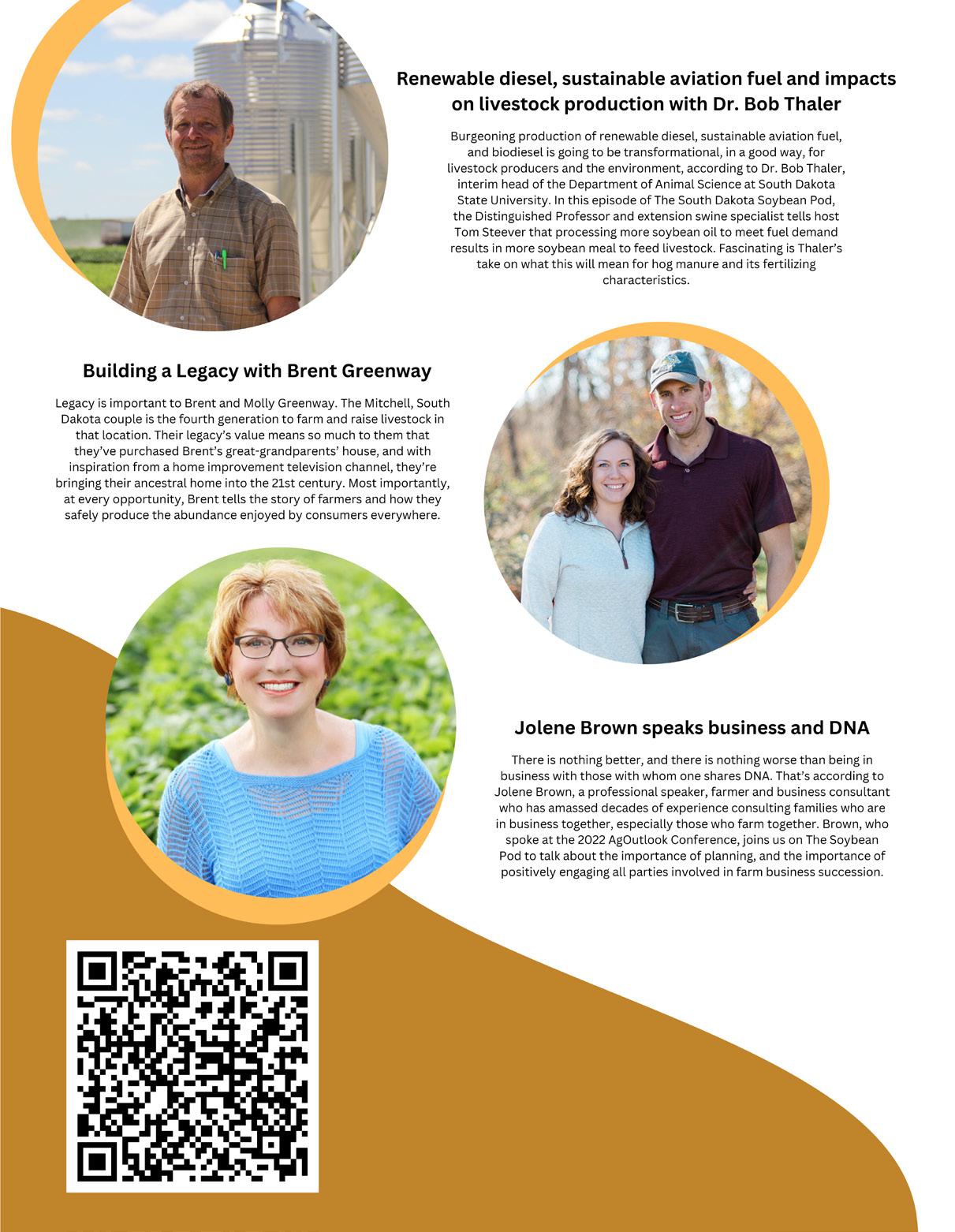
SD SOYBEAN MOROCCO TRADE MISSION BUILDS TRUST BETWEEN FARMERS AND BUYERS
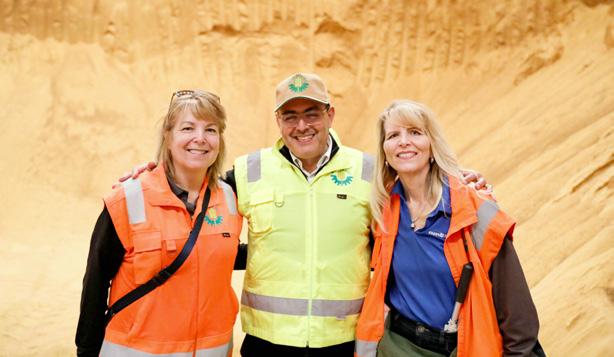
This January, a delegation of soybean farmers from South Dakota visited key sites in Morocco, including Casablanca and Marrakech. The trade mission was designed to continue growing the relationship between soybean growers in the kingdom of Morocco.
Situated on the western edge of what political scientists and economists refer to as the Middle East/North Africa (MENA) region, Morocco has solidified its status as Africa’s fourth largest economy.
“This is what we call an emerging market,” says Dawn Scheier, District 3 Director for the South Dakota Soybean Research and Promotion Council and a member of the delegation to Morocco in January. “As soybean farmers, we want to cultivate these emerging markets and other areas where we can increase soybean usage.”
Scheier, who farms near Salem, is also secretary for the U.S. Soybean Export Council (USSEC). She has a keen understanding of what’s at stake with these sorts of trade missions.
“Over 60 percent of U.S. soybeans are exported,” says Scheier. “That is why trade is very important.”

GROWTH IN THE MOROCCAN LIVESTOCK INDUSTRY
Morocco’s economy has shown steady growth in recent years and has become one of the ten largest importers of soybean meal originating in the U.S.
In fact, according to USDA data, United States soybean and meal exports to Morocco totaled $169 million in 2021.
This is largely attributed to the emergence of a stronger middle class that has shifted food preferences, including an increased demand for meat. Poultry consumption, for example, is projected to grow 5 percent annually according to USSEC.
Demand for sheep, goats and cattle is increasingly strong in Morocco, too. Meanwhile, aquaculture is a growing sector, presenting an additional opportunity on the demand side.
The South Dakota Soybean delegation discussed this growth opportunity extensively during their visit. They met with leaders of major feed processing plants and observed commerce in traditional Moroccan markets as well as more modernized grocery stores.
Scheier notes that part of the soybean checkoff strategy in Morocco has been to support growth and standardization of the livestock infrastructure there. The group’s itinerary included a stop at a training facility and discussions about food safety.
30 Spring Issue 2023 SDSL
INVESTING CHECKOFF DOLLARS
A TRUST-BUILDING MISSION
Above all else, checkoff-sponsored trade missions are designed to nurture relationships with prospective buyers.
“By going to these countries — whether that’s to the MENA region, Latin America or Southeast Asia — we are building relationships and trust,” says Scheier.
“In business, you have to have trust,” she adds. “It’s really important for us to always maintain that trust in relationships with our customers.”
When the delegation met with leaders at Morocco’s largest feed processor, EDDIK, the trust U.S. soybean growers had earned in the country was evident.

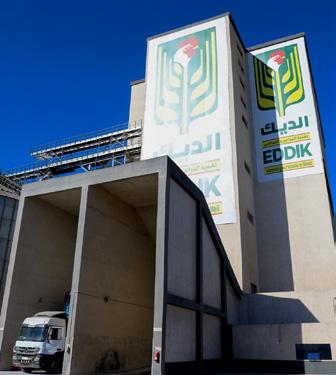



“They knew the difference — in terms of quality and the consistency of the grind — between U.S. meal and Argentinian meal,” says Scheier. “That is very interesting and encouraging to see in another country.”
LOOKING AHEAD TO NEW MARKETS
China, which imported 96.52 million metric tons of soybeans in 2021, obviously continues to loom large as the dominant export market. But it is also clear that many other countries — including Morocco and other countries in the MENA region, such as Egypt — are emerging as growing markets for U.S. soybeans.
With this in mind, South Dakota Soybean Research and Promotion Council remains focused on building relationships with these key players around the world.
Now that COVID-19 concerns have subsided some and international travel is on the rise, trade tours are at the forefront of these relationshipbuilding efforts.
“We want to make sure we have good, diverse markets for the U.S. farmer,” says Scheier. “It’s a longterm investment.”
Spring Issue 2023 SDSL 31
QUALITY COUNTS.
SOUTH DAKOTA FARMER IS EXCITED FOR THE FUTURE FOLLOWING SE ASIA TOUR.

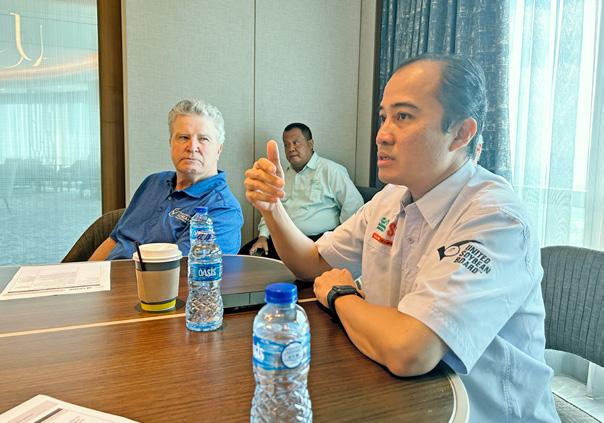
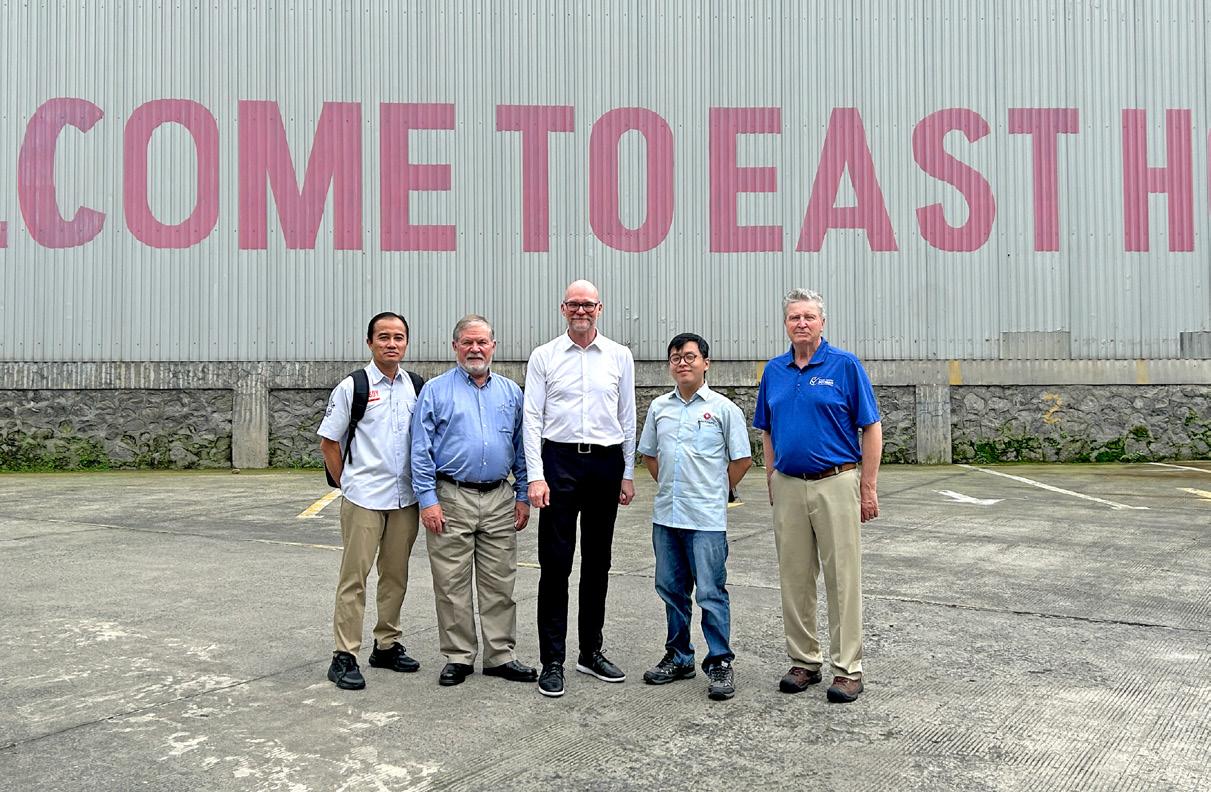 By Sydney Harris
By Sydney Harris
32 Spring Issue 2023 SDSL INVESTING CHECKOFF DOLLARS
Farmers are proactive.
They purchase crop insurance before the hailstorm hits, secure their seed long before the snow melts and sometimes they’ve even sold portions of their crop before it’s been harvested.
Therefore, it only makes sense that they’re proactive when it comes to marketing the product they painstakingly grow. Thus, Northern Soy Marketing (NSM) was born.
In February, NSM, a farmer-led board comprising North Dakota, South Dakota, Minnesota, Nebraska and Wisconsin soybean checkoffs, ventured to Indonesia to promote soybeans grown in the Northern U.S. As the most populous country and largest economy in Southeast Asia, Indonesia is an ideal target for NSM’s mission, which is to increase the profitability of soybean producers in the United States.
On the trip were South Dakota soybean grower and NSM Vice Chair Mike McCranie, University of Minnesota agronomist Seth Naeve and poultry nutrition consultant Bob Swick.
Instead, NSM encourages buyers and nutritionists to consider the critical amino acid value (CAAV). Measuring protein quality instead of quantity, CAAV is the sum of five essential amino acids - lysine, threonine, tryptophan, cysteine and methionine – as a percent of crude protein.
The resounding echo heard while in Indonesia was that though the feed mills recognize the superior quality of U.S. soybean meal (SBM), the higher price prevents them from making more purchases.
In the coming years, there are a significant amount of crush plants coming online in the United States, driven by the demand for soybean oil. Consequently, there will be an abundance of soybean meal, much of which is poised to be exported out of the PNW.

“Because there are more crushing plants coming online, the price of U.S. soybean meal will become more competitive with Brazil and Argentina,” Swick said.
To round out a successful mission in Indonesia, NSM hosted the “Essential Amino Acid Value in Soybean Meal” seminar, inviting a plethora of feed mill industry representatives and local media.
“The seminar really brought home the messaging that we pushed during our feed mill visits and allowed us to go into more detail using visual aids,” McCranie said. “And the turnout was great. When I got up to give my presentation, I was shocked at how much the room had filled.”
It can be difficult to imagine that these types of trade missions result in building quality relationships when there are thousands of miles and oceans of separation.
But it’s a small world.
While in Surabaya, the delegation met with Arya Agro Wijaya, a closed house layer farm. Andri, the general manager, went on a trade mission to South Dakota before the pandemic, where he met McCranie.
The delegation traveled to seven feed mills throughout Jakarta, the capital of Indonesia, and Surabaya, meeting with general managers, nutritionists and purchasers.
“It’s vital that our message reaches not only the nutritionists but also the folks making the purchasing decisions. We need both entities in the room,” said McCranie, who serves as treasurer on the South Dakota Soybean Research and Promotion Council. “We can talk until we’re blue in the face with the formulators who understand the science but ultimately the purchasers make the decision.”
Naeve and Swick, two industry experts, guided the conversations. Historically, soy quality is determined by the crude protein content, a measure a nitrogen, but this measurement doesn’t necessarily equate to higher protein or nutritional value. Instead, protein quality is based upon the balance of essential amino acids.
“Protein itself doesn’t paint the entire picture of quality,” said Naeve. “U.S. soybean meal should be viewed not as a commodity but as a package of nutrients for animals.”
“He walked into the room, and we immediately recognized each other, which was shocking because it’s not like I was in my local grocery store. I was in Indonesia!” McCranie said. “It made our conversation flow much better and put everyone at ease.”
NSM has its work cut out, but luckily, the farmer-led group isn’t afraid of a challenge.
As always, they will continue to serve their member states, working to grow global demand for northern-grown soybeans and shift the soybean value standard from crude protein to nutritional value.
The recent visit to Indonesia was just the beginning of realizing the full potential of U.S. SBM in not only Indonesia, but Southeast Asia.
“The trip exceeded my expectations,” McCranie said. “The conversations we had and the traction we gained were extremely promising. I’m excited to see what the future holds.”
“This trip was really important because we know that we are going to have a lot of meal coming out of our region and going through the Pacific Northwest (PNW),” said McCranie. “The best customers that we have are in Southeast Asia, so we do have to look at countries like Indonesia to expand our market.”
SOYBEAN GROWERS READY FOR POPULATIONGROWTH CHALLENGE
Soybean growers are poised to feed the growing world population. Projected late last year to eclipse eight billion people, the number of mouths to feed is staggering. Despite that, U.S. soybean growers are prepared to meet that protein demand challenge, according to Roberta Simpson Dolbeare, chairperson of the World Initiative for Soy in Human Health (WISHH). Dolbeare, in an interview for a story in the Winter 2023 edition of American Soybean, said her participation in a USDA trade mission to Kenya and Tanzania provided her with a better understanding of the rapidly growing demand for readily available and affordable protein.
“U.S. soybean growers have the ability to help fulfill that soy protein demand,” she said. “We know how to grow high-yielding soybean crops on a sustainable basis year after year. And a sizeable portion of our soybean
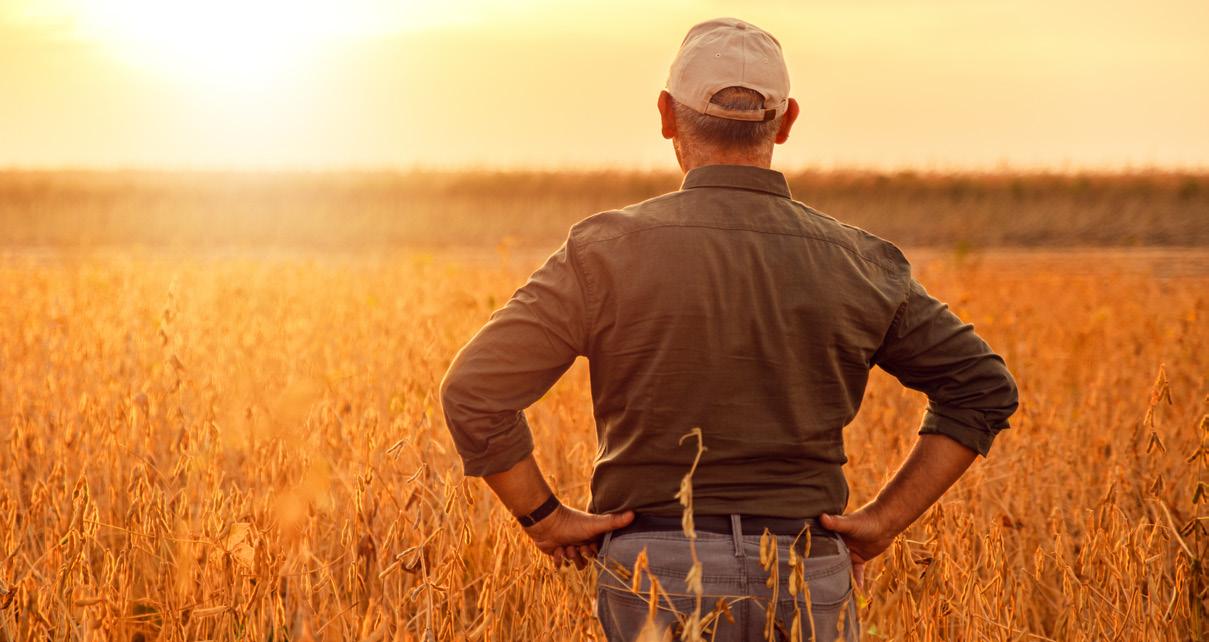
production is available for both animal feed and human foods around the globe.”
WISHH was founded more than two decades ago by farmers who saw this population growth coming, said Simpson-Dolbeare. Citing statistics compiled by the United Nations, Simpson-Dolbeare pointed out that the fastest population growth is in SubSaharan Africa – 2.5 percent per year – more than triple the global average. “I think it’s important that these expanding areas, especially ones with fast-growing younger populations, have access to quality protein,” she said. “The versatility of soy protein makes it ideal for adding to animal feeds, which in turn can be consumed by humans, as well as adding it to human foods for direct intake.”
Simpson-Dolbeare adds that food security among the world's population centers makes for a more productive and stable economy.
Specifically, the company Edesia contributes to this effort with its production of soy-based, nutrientdense food packets. Edesia is a nonprofit, Rhode Island-based enterprise that makes ready-to-use foods that help alleviate malnutrition. It’s Edesia’s aim, according to Simpson-Dolbeare, to increase the amount of soybean meal in its product formulation.
“They’re working diligently to get all their ducks in a row, so to speak, so that that can happen, that they can increase the amount of soy used. I think [Edesia has] developed a good name for themselves,” said SimpsonDolbeare, “and with some of the support that they’ve been able to achieve through USAID and UNICEF, I think they’re positioned to grow with the need and be able to distribute their food supplement products where they’re needed.”
34 Spring Issue 2023 SDSL
INVESTING CHECKOFF DOLLARS
THE FOOD SYSTEM IS DOING JUST FINE
Ray Starling is a big believer in the U.S. food system. Starling is a past national FFA officer, a former agriculture advisor to President Trump, and more recently with Aimpoint Research as an executive advisor in the agri-food supply chain. People in the agriculture sector have talked for a long time about the need to do more with less. That, according to Starling, is juxtaposed with the fact that there is a growing number of mouths to feed.
“We all in ag, at least those folks that are not iconoclastic, have agreed, ‘hey, we need a bit of an all-of-the-above strategy in agriculture,’” said Starling. “We need to obviously keep doing a lot of what we are doing and do it better and we need to do some new things beyond what we sort of think of as traditional food production.”
It’s at that point where Starling sees a conundrum. There is clearly a recognition that the world will need more grain, more protein, and more food of all types in the next 20 to 30 years, he said. Despite that, “there are still a lot of people that look at the productivity success we have today and essentially say, ‘hey, you’re doing it wrong. Big Ag has failed us in a number of ways,’ is the argument that we hear,” said Starling. “I obviously think that is over-stated.”
Starling is quick to concede that improvements always need to be made, which is the case for any industry, but he adds that a prevailing misconception is that the existing food system is

broken. On the contrary, Starling maintains that American agriculture has been extraordinarily successful in doing everything that has been asked of it. “We have made food very cheap. We have done that in a way that has not burned through excessive resources. In other words, when I think about our greatest victory, it is that we are producing a massive multitude or sort of multiplication, if you will, of the product that we were producing at the end of World War II, and we have done that without massively increasing inputs,” he said. “We’ve actually held them about the same over the course of the last 70 years.”
If there is to be an argument about whether the food system is good or bad, Starling says the best evidence is the productivity of the U.S. farmer while agriculture inputs have remained constant. Specifically, Starling draws attention to production volumes in soybeans, corn and forage, as well as feed conversion in protein animals. “All of those numbers tell an impressive story about what we’ve done in American agriculture.”
Starling says reasoning and evidence are in agriculture’s favor, adding that we should not abandon the system we’ve built over the last 70 years. “I have trouble concluding that the food system is broken. I have trouble concluding that this industry is both starving and stuffing people to death at the same time,” said Starling. “That level of hyperbole is very much a turn-off to me and it’s hard for me to take it seriously.”

Spring Issue 2023 SDSL 35
INVESTING CHECKOFF DOLLARS
( YOU )

You just increased your sales to Egypt 708%. Bon voyage.






All soybean farmers, including you, have been busy racking up big sales with export markets. How? By pooling your resources through your soy checkoff. Learn how your soy checkoff is bringing tangible returns back to you and your operation at unitedsoybean.org/hopper
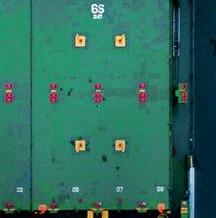

Moving Soy Forward. Moving You Forward.



















 By Jerry Schmitz,
By Jerry Schmitz,













 By Kurt Lawton for SD-USDA NRCS and SDSA Soil Health Initiative
By Kurt Lawton for SD-USDA NRCS and SDSA Soil Health Initiative










































 By Sydney Harris
By Sydney Harris













